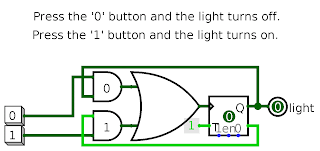The working of an optical mouse can be divided into 2 broad areas -
- The OPTICAL part (discussed in this post)
- The ELECTRONICS (DIGITAL SIGNAL PROCESSING) part (not discussed in this post)
This post completely describes the optical aspect of the optical mouse (only). The electronics aspect is not discussed here.
Intended Audience -
This post is intended for those having elementary optics knowledge. If you wish to revise your preliminary optics knowledge, you can go through the beginning of these weblinks - refraction, total internal reflection, convex lens.
Working of an optical mouse[in brief] -
At the bottom of your mouse, you can see a red light (or sometimes blue or no light, meaning infrared) When you move the mouse, this light strikes the bottom surface on which the mouse is moving, gets reflected back and falls on the another part of the mouse, where a lens collects all the light and focuses it on a sensor with a DSP chip. This chip handles the computational aspect of the mouse working where it decides, depending upon the light falling on it, the direction in which the mouse moved and accordingly sends the signals to the computer. The optical components of the mouse are discussed below in greater detail.
At the bottom of your mouse, you can see a red light (or sometimes blue or no light, meaning infrared) When you move the mouse, this light strikes the bottom surface on which the mouse is moving, gets reflected back and falls on the another part of the mouse, where a lens collects all the light and focuses it on a sensor with a DSP chip. This chip handles the computational aspect of the mouse working where it decides, depending upon the light falling on it, the direction in which the mouse moved and accordingly sends the signals to the computer. The optical components of the mouse are discussed below in greater detail.
Mouse Internals -
The mouse internals have been shown pictorially, for easy understanding.
The mouse internals have been shown pictorially, for easy understanding.
 |
| On removing the top cover of the mouse. Visible components are labelled. |
 |
| Separating the electrical (top part) and the optical (bottom part) components. The optical component is just the transparent part, placed on the bottom (orange) support. |
 |
| The system consists of 2 simple optical components. Their side view is shown. |
 |
| Front view of optical component #1 |
Optical Component #1: The complete blue highlighted part is the light transmitter. (There is a schematic below which can help in visualizing it better). It consists of a half convex lens/part and a long tunnel to carry light rays via TIR (Total Internal Reflection). The convex part above is to increase the field of view ie to take in more light without loosing them out due to non TIR ie to the make critical angle effectively smaller
 |
| Top view of optical component #2 |
Optical Component #2: It is a simple convex lens, for magnifying the contents below it.
The small 42sec video below shows the 2 components from various angles. Note its size, as compared to my fingers.
I have shown how the real optical components look like above. Here is a schematic of the same, from the side view -
 |
 |
| Assume points P and U are on a rough surface, hence not getting reflected at same angles. |
Optical Working:
Component #1 has 2 subcomponents -
The convex lens of component #1 (bulge), which collects light from a large solid angle and passes it to 2. The transmitter of component #1 (slanted rectangular part), which transmits light received at input to its output using total internal reflection. Component #1 thus illuminates the surface on which the optical mouse is moved.
Component #2 is a simple convex lens which focuses the illuminated surface below on the camera pin hole above, from .
Experiment -
I performed a simple experiment to understand (and verify) the working of the optical component. The aim was to try to read, using the optical component, the alphabets "A B C D E F G H" written on the paper in a small font. (See pic below).
I performed a simple experiment to understand (and verify) the working of the optical component. The aim was to try to read, using the optical component, the alphabets "A B C D E F G H" written on the paper in a small font. (See pic below).
 |
| The (transparent) optical system (along with its orange support) is moved on the paper which has handwritten letters "A B C D E F G H", just like we move the mouse on a plain surface. |
Observation & Conclusion -
Observation: After illumination and magnification, the letters could easily be read using the optical component.
Conclusion: The optical aspect involved in an optical mouse is theoretically quite simple.
The aftermath:
The DSP takes successive photos of the surface below & using the difference in successive images, figures out the direction in which the mouse moved. More information can be found on Wikipedia.
--------------------------------------------------------------------------------------------------------------------------
In one of my advanced optics course (EPL445) at IITD, we were asked to give a small presentation on some optical system, stressing on the optical aspect of it. While most students gave presentations on complex optical systems, none were a complete explanation since they were too complex to be clearly explained in a short duration of 30 minutes. So, I decided to present on this topic (which was actually very simple considering the level of the course) in the interest of time.









